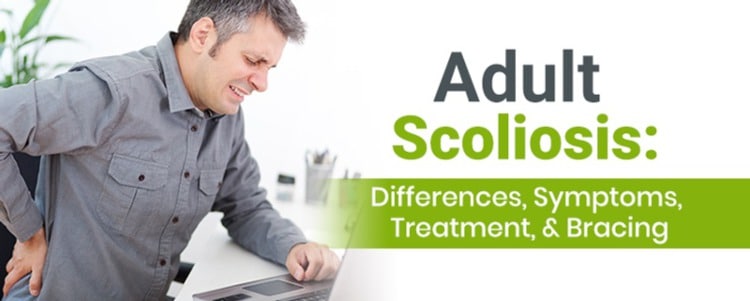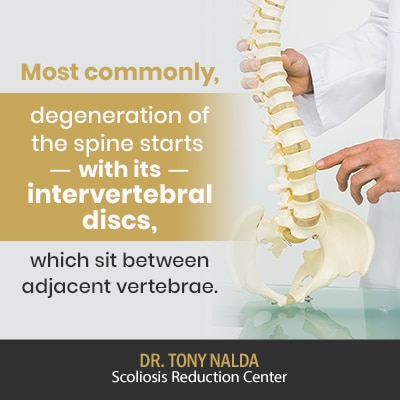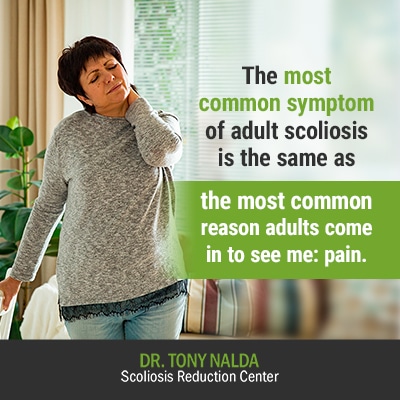
While scoliosis is far more prevalent in younger age groups, adults can develop it too. A significant difference between adult and adolescent scoliosis is pain. While adolescents don’t generally find the condition painful, adults experience scoliosis-related pain more frequently. Treatment differences involve accounting for different pain levels, progressive rates, spinal flexibility, and any spinal degeneration related to aging.
The two most common types of adult scoliosis are adolescent scoliosis in the adult (ASA) and degenerative scoliosis; important differences between adult and adolescent scoliosis are pain and rates of progression, although no two cases are the same, which is why treatment plans need to be customized.
To start our discussion of adult scoliosis and the differences between the condition’s most prevalent form, adolescent idiopathic scoliosis (AIS), and the types that affect adults, let’s touch on some general condition characteristics.
Table of Contents
When a person of any age is diagnosed with scoliosis, this means their spine has an abnormal sideways curvature, that also rotates, and is of a certain size.
The size of the curvature places the condition on its severity scale of mild, moderate, severe, or very severe, and this is determined by a patient’s Cobb angle:
A patient’s Cobb angle is a measurement taken from X-ray images. By drawing lines from the tops and bottoms of the most-tilted vertebrae of the curve, the intersecting angle is measured in degrees, and this tells me how far from a healthy alignment a patient’s spine is.
In a healthy spine, its bones (vertebrae) are stacked on top of one another in a straight alignment; in a spine that’s misaligned, the vertebrae are no longer stacked on top of one another as they should be, and this can cause, or be caused by, the development of scoliosis.
While every case is different and will produce its own unique symptoms, generally speaking, the higher a patient’s Cobb angle, the more severe the condition is, and the more likely it is that it will produce noticeable symptoms such as pain (in adults) and postural changes.
In addition to condition severity, other important patient/condition characteristics that shape a person’s experience of life with the condition, and the design of their treatment plan, are curvature location, condition type, and patient age.
For our current purposes of exploring adult scoliosis and how it differs from adolescent idiopathic scoliosis, particularly in symptoms and treatment, we’re going to focus on patient age and condition type.
When it comes to scoliosis treatment, patient age is an important factor not only because it can affect a person’s overall health, physical fitness, and responsiveness to treatment, but also because it factors into how painful a condition is and helps drive its progressive rate.
Before we move on to discussing the ‘progressive’ condition characteristic, let’s talk more about how patient age helps determine how painful a condition is, as this is an important difference between scoliosis in adults and scoliosis in adolescents.
Patient Age and Pain
As mentioned, scoliosis most commonly affects children and adolescents, and for these younger age groups, the condition is not commonly described as painful, but why is that?
It might seem like a spinal condition that involves a structural abnormality within the spine itself, capable of causing postural changes, would automatically be painful, but that is not always the case, and this has to do with skeletal maturity.
In patients who have not yet reached skeletal maturity, which means they are still growing, and that includes their spines.
As a patient grows, their spine is experiencing a constant lengthening motion, and this counteracts the compressive force of the scoliotic curve; however, in adult patients who have reached skeletal maturity and are no longer growing, their spines are vulnerable to compression caused by the abnormal curvature.
As scoliosis develops, a lot of uneven forces are introduced to the body, concentrated in the back and its surroundings.
These uneven forces put pressure on different areas of the spine and back, and this can cause compression not just felt by the spine, but also its surrounding muscles and nerves.
As an abnormal spinal curvature develops and progresses, it puts more strain on the spine and its surrounding muscles as they play a role in providing it with essential support and stabilization.
In addition, the postural changes that scoliosis can cause can also lead to uneven muscle use, and this can cause muscle strain, soreness, and stiffness.
When you think of nerves, think of branches on a tree fanning out in all directions. If a scoliotic curve compresses a nerve near the spine, it can be painful not only where the nerve is located, but also throughout the body as radiating pain.
In fact, when it comes to adult scoliosis, it’s most often this type of pain that brings adults in to see me for a diagnosis and treatment.
So to summarize, is scoliosis painful? The answer will vary based on a number of factors, but patient age is one of the most important as in adults, the condition can cause varying levels of pain, but in children and adolescents who are still growing, it’s generally not painful.
Another important condition characteristic that patient age affects is progression, so let’s talk about what it means when a condition is classified as ‘progressive’, and how age factors into patients’ progressive rates.
Patient Age and Progression
When a condition is classified as ‘progressive’, this means that it is in its very nature to get worse over time, especially if left untreated, or not treated appropriately.
As discussed in the ‘Cobb angle’ section, scoliosis develops across a wide severity spectrum ranging from mild to very severe, and this is why it’s crucial that every treatment plan is 100-percent customized to address the specifics of each patient and their condition.
Progression is an important condition characteristic, particularly when it comes to designing an effective treatment plan.
As scoliosis is incurable, controlling its progressive rate is a key focus of treatment at any age, and a patient's progressive rate is governed by different factors, but patient age is an important one.
As mentioned, those who have not yet reached skeletal maturity don’t commonly describe their conditions as painful, but in most cases, these younger patients are far more at risk for rapid-phase progression than adults; this is because growth is the number-one trigger for progression.
Adolescents (aged 10 to 18) are in, or are entering into, the stage of puberty which features rapid and unpredictable growth spurts, and this is why proactive treatment of AIS is so important: so that work can be done to help these patients avoid the hardships associated with reaching higher stages of progression.
When I design a treatment plan for an adolescent, it involves a lot of monitoring to see if their condition is progressing, at what rate it’s progressing, how treatment is impacting that progressive rate, and adjusting treatment plans as needed to stay ahead of patients’ progressive lines.
When it comes to adult scoliosis treatment, progression tends to be slower, but every case is different and will depend on the type of scoliosis an adult is facing, and it is still an important factor.
To further explore the topic of adult scoliosis progression, let’s move on to ‘condition type’ as the two types of scoliosis that most-commonly affect adults are adolescent scoliosis in the adult (ASA) and degenerative.
The most common form of scoliosis that affect adults is idiopathic, also known as ‘adolescent scoliosis in the adult’ (ASA), and these cases are adults who had adolescent idiopathic scoliosis (AIS) in their younger years and matured with it unaware.
It might seem difficult to imagine that a person could live for so many years with a progressive and incurable spinal condition without noticing some signs or symptoms; if you recall the wide range of severity levels, mild cases in particular aren’t commonly associated with producing functional deficits or noticeable symptoms.
In addition, as discussed, as AIS is not commonly painful, this is another reason the condition can go unnoticed for so long. As skeletal maturity is reached in adulthood, growth is no longer occurring, and the spine is vulnerable to the compressive force of the curvature, and it’s the pain it causes that most commonly brings these adults in to see me for a diagnosis and treatment.
The unfortunate reality is that if these adults had been diagnosed and treated during adolescence, their spines would be in far better shape than by the time they come to see me; that being said, it’s never too late to work towards an improvement through proactive treatment.
While every case is different, generally, many people with ASA don’t start to experience pain or other noticeable symptoms until their 30s, or even their 50s, and as a condition progresses, these signs and symptoms can increase, especially if left untreated.
When it comes to progression, while adolescent patients are more at risk for rapid-phase progression due to the growth spurts associated with puberty, cases of ASA are still progressive, and as spinal degeneration due to aging comes into play, progressive rates can increase.
On average, for adults in their 30s and 50s, patients tend to have a progressive rate of one degree a year, and it’s common for adults in this age range to start experiencing varying levels of pain and mobility issues.
Adults in their 50s and 60s with ASA tend to experience a faster progressive rate, similar to what adults with degenerative scoliosis face.
Adult degenerative scoliosis (ADS) tends to develop in adults over the age of 40 because it’s caused by spinal deterioration that can accompany aging. It is also referred to as ‘de novo’ scoliosis, meaning it is a condition that has developed anew in adulthood, unlike ASA.
 Most commonly, degeneration of the spine starts with its intervertebral discs, which sit between adjacent vertebrae.
Most commonly, degeneration of the spine starts with its intervertebral discs, which sit between adjacent vertebrae.
The intervertebral discs are made up of two parts: a tough durable outer layer and a soft gel-like interior. They help preserve the health and function of the spine by providing cushioning between the vertebrae so friction isn’t generated during movement.
The tough outer layer provides the spine with structure, holding its parts together, and the soft interior helps give the spine flexibility.
When the discs start to deteriorate, they can become dehydrated and lose height, causing a shift in the positioning of the vertebrae. As this develops over time, the spine becomes less stable and its ability to maintain its healthy curves and alignment is compromised.
In addition, the presence of other spinal conditions such as osteoporosis and osteoarthritis can also lead to the development of degenerative scoliosis.
When it comes to progression in adult degenerative scoliosis, these patients have the additional factor of spinal deterioration to contend with, which is why progressive rates can increase for older adults facing ADS.
While many cases of ADS have Cobb angles of 30 degrees or less when they are first diagnosed, it’s not uncommon to see larger curvatures.
The important thing to understand is that while a Cobb angle of 30 degrees would place patients in the ‘moderate’ scoliosis classification, even cases of moderate ADS can easily exceed 40 degrees over time, moving them into the ‘severe’ classification.
Again, while every case is different, depending upon a number of patient and condition characteristics, generally, ADS progression falls into a range of 0.5 to 3 degrees a year; while this sounds like a slow rate, over a 10-, 20-year period, the cumulative effect can be a large curvature increase, which is why proactive treatment is so important.
 The most common symptom of adult scoliosis is the same as the most common reason adults come in to see me: pain.
The most common symptom of adult scoliosis is the same as the most common reason adults come in to see me: pain.
As explained earlier, scoliosis-related pain is experienced more frequently in adults, as compared to children and adolescents.
Compression of the spine and its surrounding muscles and nerves can cause varying levels of pain that can range from mild and intermittent to chronic and debilitating, especially if compressed nerves are involved; a compressed nerve can cause pain and discomfort felt in areas of the body far from the nerve’s location.
Often, radiating pain is felt in the legs and feet; pain and related mobility issues are what alert many adult patients to the reality that something is wrong.
In addition, as an abnormal spinal curvature progresses, it can cause postural changes that can also lead to uneven muscle wear and strain, and this can also cause pain.
A loss of height can be another symptom of spinal misalignment that can indicate the presence of adult scoliosis.
So now that we know the two most common types of scoliosis that develop in adults, as well as some common symptoms, what does treatment for adult scoliosis involve?
As scoliosis develops across such a wide severity spectrum and has different types, every case is unique, which is also why the nature of the condition necessitates such a highly-customized treatment approach.
Here at the Scoliosis Reduction Center, I offer patients an integrative chiropractic-centered approach that prioritizes the spine’s overall health and function in treatment.
When it comes to treatment for adult scoliosis, again, every case is different and will require the crafting of a highly-specific treatment plan, but in general, the main scoliosis -specific treatments for adults involve gentle targeted chiropractic adjustments, exercises and stretches, and corrective bracing when necessary.
We are always working towards a curvature reduction as impacting the condition on a structural level is a big part of treatment success; however, with adults, sometimes work has to be done at the onset of treatment to increase spinal flexibility so the spine is more responsive to treatment and scoliosis-specific exercises can be utilized.
In addition, a big focus in the treatment of adult scoliosis is stabilizing the spine, especially with degenerative scoliosis because as the spine deteriorates, a scoliotic curve can progress faster.
This is another difference in the treatment process between adolescents and adults: with many younger patients, their spines are more flexible, and as they are young, their conditions haven’t progressed significantly over time, which increases spinal rigidity, and gives the body time to adjust to the abnormal curvature’s presence.
Another important facet of treatment is scoliosis bracing, and here at the Center, we use the ultra-corrective ScoliBrace.
While bracing is a common component of AIS treatment, it’s not as commonly used in the treatment of adult scoliosis.
Traditionally, bracing in adult scoliosis treatment was used mainly for short-term pain relief and to help support and stabilize the spine; however, in more modern approaches, such as my functional and chiropractic-centered approach, the type of brace used, and how it’s combined with other complementary treatment disciplines, can also offer corrective potential for my adults patients.
While the braces used in the traditional approach, like the Boston brace, focus on controlling progression and are ineffective when it comes to achieving corrective results, the modern ScoliBrace addresses the 3-dimensional nature of the condition and not only helps with pain, support, and stability, but also has the potential to impact the condition on a structural level.
Here at the Center, first and foremost, my focus is impacting scoliosis on a structural level because it involves a structural abnormality within the spine itself.
While a huge curvature reduction is not always possible with my adult patients, it’s always worked towards, while also making improvements in the areas of better support and stabilization for the spine.
While there are some schools of thought that assume once skeletal maturity is reached, the challenge of treating scoliosis, in terms of progression, is removed, this is not the case.
While growth is the number-one trigger for progression, which is why it’s a key focus in treating children and adolescents with scoliosis, other factors such as slow progression over time and spinal degeneration can also lead to significant curvature progression in adults.
When it comes to treating the two most common types of adult scoliosis, adolescent scoliosis in the adult (ASA) and degenerative scoliosis, while they might not be at as high a risk for rapid-phase progression as adolescents, they do still progress; over 10, 20, 30 years, even a glacial progressive rate can have the cumulative effect of a large abnormal spinal curvature developing over time.
As people age, the spine can face natural degenerative changes, which tend to start with the intervertebral discs, and when parts of the spine start to deteriorate, scoliotic curves can progress faster as the overall health, strength, and function of the spine are compromised.
So while growth-related progression is more of a focus in treating the condition’s most-prevalent form (AIS), treatment for adult scoliosis also has to address progression.
In terms of the different symptoms of scoliosis in adolescents and adults, the main difference is pain. While children and adolescents don’t commonly experience a lot of pain with scoliosis, adults experience it more frequently, and pain is the most common reason they seek out a diagnosis, if they haven’t already received one, and treatment.
Here at the Scoliosis Reduction Center, I adjust treatment plans to address important patient and condition characteristics such as age, condition severity, curvature location, and condition type.
While no treatment results can ever be guaranteed, both for adolescents and adults, in terms of potential treatment success, the sooner proactive treatment is applied, the better.
